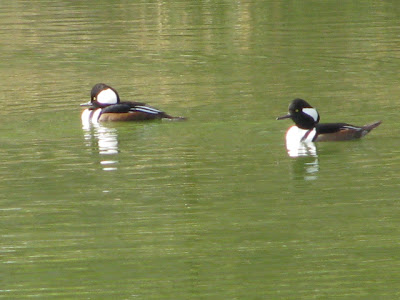December 10, 2010: Posted the above new photo taken today. There are now a couple dozen Hooded Mergansers at Charleston's Magnolia Cemetery.

This small duck has such a striking look.
The Hooded Merganser has returned to the Magnolia Cemetery ponds for the fall and winter. The male sports distinctive white patches bordered by black on his paper-thin head. The female doesn't have the patch but instead more an orange tinge to her head.
Affectionately called "Hoodies," these ducklike birds spend most of the year north in Canada, Alaska and the Great Lakes region. In November the past two years I've noticed them locally at Charleston's Magnolia Cemetery.
They are the cutest little things don't you agree? Cute yes, but not so little. They are 16-19 inches long so a bit big for your bathtub! A smaller Hoodie rubber ducky would work though.
They're called "Hooded" Mergansers because they have a crest at the back of their heads that can be expanded or contracted. The female (above left) is in hooded mode.
View from behind a Hoodie. The white on the wings nicely complements the other white markings giving the bird an artsy, almost toylike look.
Hoodies are quite active and social. The males' mating and masculine antics can be very animated. According to Reader's Digest's "Book of North American Birds": They swim circles around females and if ignored too much will leap vertically from the water and execute a perfect somersault. She's got to at least give him style points for effort." I've yet to personally see such a leap but hope I will sometime!

The Hoodies' eyes seem too tiny for their big heads. But observant and quick they are. They notice even my stealthiest efforts to get closer and quickly change directions...away from me.

The Meganser's will likely stay here in the South until March or so before flying back to their Northern ranges.
So we'll enjoy them while they are in our area!
As it gets cooler here, just where your hoodie and go see these Hoodies.
For more on this unique and sport bird, go to
this site or this one:
http://identify.whatbird.com/obj/390/_/Hooded_Merganser.aspx



















